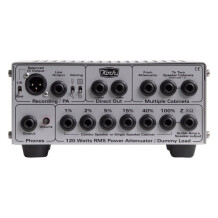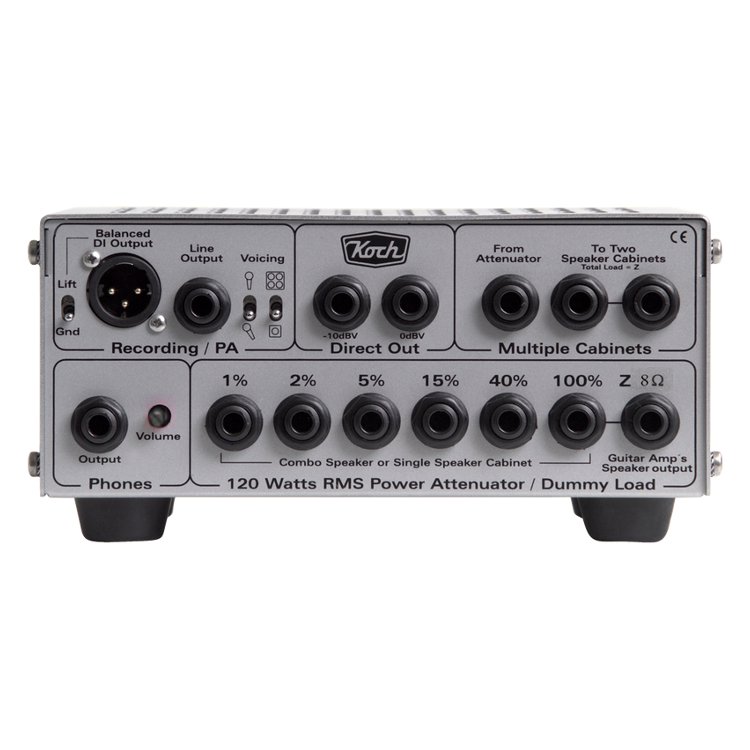Not satisfied with those reviews?
Filter
Our members also liked:
4.8/5(6 reviews)
83 %
17 %
Write a user review
Users reviews
 Mark TwangPublished on 11/15/09 at 03:24 (This content has been automatically translated from French)Koch offers us a box of tricks which innovates in the world of direct box: it is an all in one particularly attractive characteristics. It's simple: the paper is simply indispensable tool for users of tube amp.
Mark TwangPublished on 11/15/09 at 03:24 (This content has been automatically translated from French)Koch offers us a box of tricks which innovates in the world of direct box: it is an all in one particularly attractive characteristics. It's simple: the paper is simply indispensable tool for users of tube amp.
- Dummy load: dummy load allows you to use an amp head without plugging in an HP. Recall that in normal times, such manipulation led to toast the output transformer of the amp. Attention to the order must choose between the Model 4 ohms, 8 ohms or 16 ohms.
- Attenuator Power: 6 slices ranging from 100% (no attenuation) to 1% (maximum attenuation).
- Transmission line: two sections of direct outputs, one filtered (Recording) and the other not. The filtered output is the mos…Read moreKoch offers us a box of tricks which innovates in the world of direct box: it is an all in one particularly attractive characteristics. It's simple: the paper is simply indispensable tool for users of tube amp.
- Dummy load: dummy load allows you to use an amp head without plugging in an HP. Recall that in normal times, such manipulation led to toast the output transformer of the amp. Attention to the order must choose between the Model 4 ohms, 8 ohms or 16 ohms.
- Attenuator Power: 6 slices ranging from 100% (no attenuation) to 1% (maximum attenuation).
- Transmission line: two sections of direct outputs, one filtered (Recording) and the other not. The filtered output is the most comprehensive: a balanced output XLR and unbalanced in jack. The filter simulates the uptake by micro two voicings, one emulating the axis of the microphone, the other type of cab (1 or 4hp). No selection on the type of cab (open / closed) nor the ambience of the room. The other section (Direct Out) that is equipped with unbalanced outputs type jack, one attenuated (-10db) the other not.
- Headphones output allows you to play with his amp head at night without disturbing anyone.
- Multiplication of cab: what connect two cabs to the output of the attenuator ... provided that the sum of the output impedance is equal to the input impedance (4, 8 or 16 ohms depending on your model LB120II)
Supplied accessory: a cord 2m long HP, 2 x 1.5mm ², with Switchcraft plugs straight.
In short, it is near perfection ... but I take two points because of the fixed impedance of loadbox.
READ FOR NOT BLOW YOUR AMP
1. One connects the output of the amp head WITH A CABLE HP unshielded input Z = x ohms at the bottom right.
2. The cab is connected to the output of a wafer and a single - always with a speaker cable - the power atténuatueur.
or
connecting a small cord IN CABLE HP output of a portion of the attenuator to the input of the section Multiple cabinet (entry named "From Attenuator") and then connects the two cabs on the "To Two Speakers - Total Load = Z ohms.
or
we do not branch cab (thank you to the dummy load) and you connect a headset
and / or
no one branch is no cab and connects to the console by one of the direct output, filtered or not. After, you have to make your sauce to treat the resulting sound.
On the "Multiple Cabinet": it is equipped with parallel outputs, making it a bit useless for me. My amp can get out of 8 or 16 ohms, but as Loadbox impedance is fixed impedance (16 ohms in my case), if I want to connect two speakers, I can not use the V112HTV (16ohms): I need two 32-ohm cabs - which is pretty rare - so that their total load is 16 ohms. This is less problematic on models 8 ohms (thus operating with two cabs into 16 ohms) and 4 ohms (two 8-ohm cabs).
Again, it is near the perfection but I take two points because of this problem fixed impedance.
- Power Attenuator Section:
I find it really well, fairly transparent up to 5% mitigation. I still feel it loses a bit of articulation, but as I use the supplied speaker cable, not necessarily at the top, I expect to receive a second Evidence The Siren II to be categorical. A 1% and 2%, it seemed that the sound became more saturated buzzing. Anyway, special mention for the opportunity to change mitigation on the fly, without having to turn off the amp head, without audible plop ... it's really useful on an amp without master volume to match the volume of the clear and the sound saturated.
- Recording Section "direct output filtered.
The speaker simulation is good but very neutral with respect to the sound of the Alnico Blue is not really convincing. In my opinion, it can not substitute for direct drive by micro ... but can probably add on an additional track. If we really wanted to use in recording, as there is no integrated treatment room, think about adding a bit of reverb on the console so that it sounds good.
Both options are voicing rather subtle but real: it was more acute with the micro axial position, the more serious the position 4x12 cab. "Reproach: We can not disengage the internal speaker simulation, it is therefore not possible to use the balanced output without passing through the filter, which is a shame if we intend to use another speaker simulation, the more powerful behind. Fortunately, there is the Direct Out section.
- Section Direct Out "direct out unfiltered."
An unbalanced output unattenuated, another at-10db. I will try later to record with, if I can get hold of a simulation of HP software. Complains: no balanced XLR output for this section.
- Headphone output:
The result is really not very pretty. Better to plug into a table and plug in the headphones on the table. An output therefore not very efficient but still useful if you have nothing else handy.
I remove a point for the headphone output and disappointing for the lack of balanced output unfiltered.
1st review hot on the Koch LB120II 16 ohms connected between a Vox AC 15 head and cabinet HTVH 112 HTV Vox Celestion Blue Alnico mounted.
Tentative conclusion:
- A versatile tool really useful thanks to the Dummy Load ally based direct box.
- A very good attenuator. I can finally play with the saturation of my Vox natural home. For me, it will be from 15% mitigation on the day and 5% in the evening. The 40% looks to me ideal for a quality mic to capture a volume humanly bearable home studio.
- An HP calculator correct but not respect your sound if you're used to the character of your HP (Blue Alnico, Greenback ...).
- Features crippled because of the fixed impedance and speaker emulation not removable.
In short, a versatile tool that has the huge advantage of being without a competitor in the market (pending release of a possible rival in NOS) and that will make great service, but misses his vocation as a tool ultimate cause of universal design to fixed impedance, the lack of balanced output unfiltered and weakness of the headphone output.
SUGGESTION FOR THE GENTLEMEN OF AT KOCH: please, install an insert jack Neutrik locking input on Z, so as not to risk being unplugged accidentally when the head is turned!See less150







